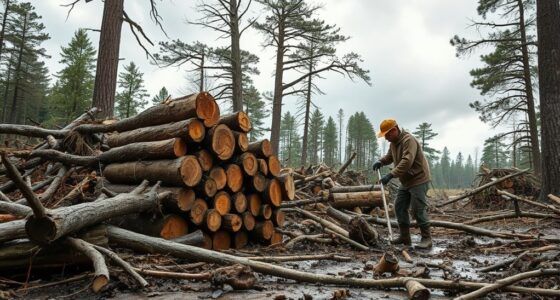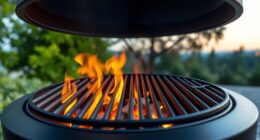To split firewood easily and burn efficiently, aim for a moisture content between 15% and 20%. Well-seasoned logs within this range are easier to handle, ignite quickly, and produce less smoke and creosote. Using a moisture meter can help you check if your wood is properly dried, while proper stacking and ventilation keep moisture levels balanced. Keep exploring to discover more tips on maintaining ideal moisture for the best firewood performance.
Key Takeaways
- The ideal moisture content for splitting firewood is between 15% and 20%.
- Moisture meters provide quick readings to ensure logs are within the optimal range.
- Proper seasoning and storage help maintain logs at the ideal moisture level.
- Excess moisture above 20% makes logs harder to split and burns less efficiently.
- Regularly testing moisture content prevents reabsorption of moisture and ensures optimal splitting conditions.
Understanding the Importance of Moisture Content in Firewood
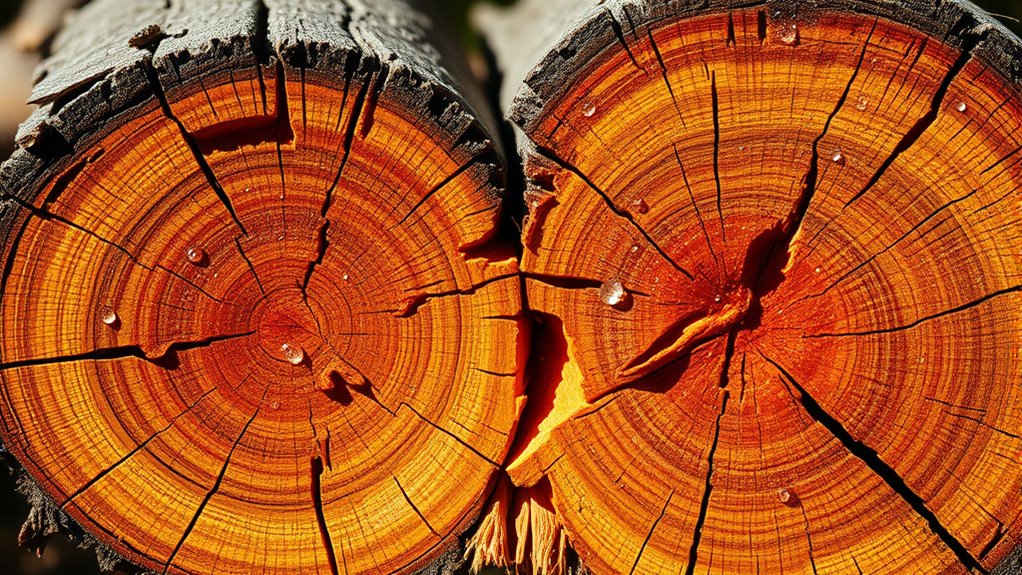
Understanding the importance of moisture content in firewood is essential for ensuring efficient and safe burning. When wood has the right moisture level, its density remains ideal for combustion, providing more heat and less smoke. If the wood is too wet, moisture migration occurs within the log, making it harder to ignite and causing inefficient burning. Excess moisture also leads to lower heat output and increased creosote buildup in your chimney, which can pose fire hazards. Properly seasoned firewood has a balanced moisture content that promotes even moisture migration, allowing the wood to burn cleaner and more completely. Recognizing how moisture impacts the physical properties of wood helps you select and prepare logs that burn safely and efficiently. Additionally, using air purifiers to improve indoor air quality can help reduce residual smoke and pollutants from incomplete combustion. Maintaining the correct moisture content is crucial for optimizing combustion efficiency and reducing environmental and health hazards. Regularly checking the wood’s moisture level with a moisture meter can help ensure it falls within the ideal range for safe burning. Incorporating natural drying methods can also enhance the seasoning process, leading to better combustion outcomes.
The Ideal Range of Moisture Levels for Splitting
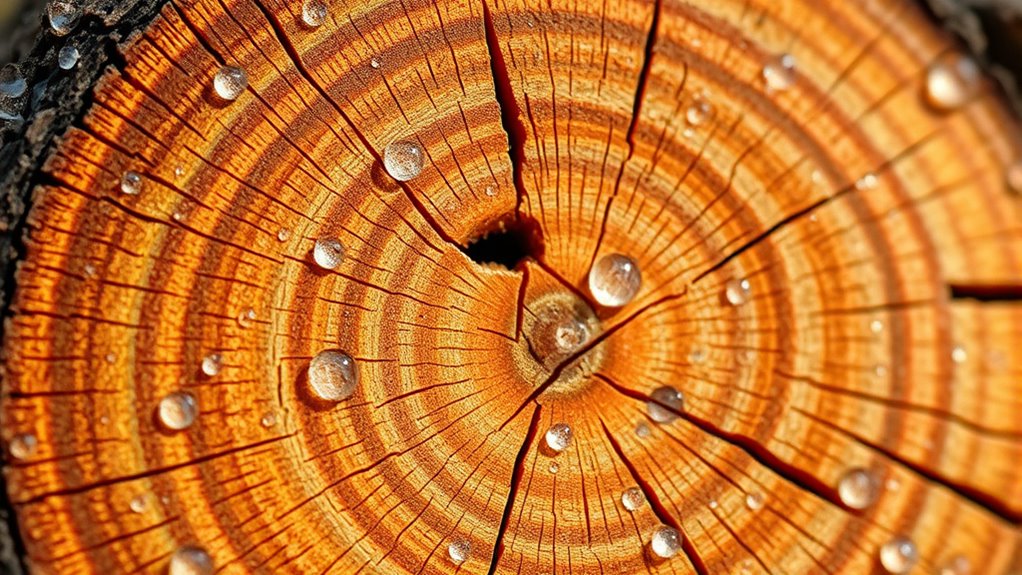
To guarantee safe and efficient splitting, firewood should have a moisture content between 15% and 20%. Using moisture meters helps you accurately assess when your logs are within this ideal range. If logs are too wet, they’re tough to split and produce excessive smoke when burned. If they’re too dry, they may crack or crumble. Proper seasoning techniques, like stacking logs in a dry, ventilated area, ensure they reach and maintain this moisture level. Monitoring moisture content regularly allows you to adjust your seasoning process as needed. Keeping logs within this range makes splitting easier and ensures your firewood burns efficiently with less smoke, giving you cleaner and more reliable heat. Additionally, understanding the signs of spoilage helps prevent using compromised wood that could impact burning quality. Regularly inspecting logs for mold, foul odors, or pests can help identify wood deterioration early and avoid potential hazards. Properly seasoned logs also reduce the risk of incomplete combustion, which can lead to increased creosote buildup in chimneys and potential fire hazards. Employing moisture meters is an effective way to maintain the optimal level and ensure your firewood performs well during the heating season. Using advanced filtration systems in your home can further improve indoor air quality by capturing airborne pollutants from burning seasoned wood.
Methods to Measure Log Moisture Content Accurately

Measuring log moisture content accurately is essential for ensuring your firewood is properly seasoned. Using reliable tools helps you avoid guesswork and guarantees efficient burning. Moisture meters are quick and portable, providing instant readings by inserting probes into the wood. Alternatively, oven testing involves drying a sample in a controlled oven and calculating moisture percentage, offering precise results. Here’s a comparison:
| Method | Pros | Cons |
|---|---|---|
| Moisture Meters | Fast, easy, portable | Less precise for certain woods |
| Oven Testing | Highly accurate | Time-consuming, requires equipment |
Choosing the right method depends on your needs. Moisture meters work well for quick checks, while oven testing ensures accuracy when precision matters most. Proper measurement keeps your logs at suitable moisture levels for burning. Additionally, understanding AI safety measures can help prevent potential risks associated with automated decision-making in forestry and environmental management. Incorporating proper calibration of your moisture measurement tools can further improve accuracy and reliability in your readings. Regularly maintaining your equipment ensures consistent performance and trustworthy results. To optimize your firewood, consider testing at different times of the year as moisture content can vary seasonally, impacting burning efficiency. Being aware of industry standards for moisture content can also guide you in selecting the best logs for burning.
Techniques to Achieve and Maintain Proper Moisture Levels

Achieving and maintaining proper moisture levels in your firewood requires implementing effective techniques that promote thorough drying and proper storage. Using moisture meters allows you to accurately monitor the wood’s moisture content during the seasoning process. Proper wood seasoning involves stacking logs in a well-ventilated area, off the ground, and protected from rain and direct sunlight. Turning or rearranging the logs periodically ensures even drying. Cover the top of the stack to protect it from moisture while leaving the sides open for airflow. Ensuring adequate airflow is essential for efficient drying and prevents mold growth. Regularly inspecting your firewood with a moisture meter can help you determine when the wood is ready for burning, reducing the risk of excess creosote buildup in your chimney. Additionally, understanding celebrity transformations can inspire you to adapt and improve your own techniques, much like how celebrities evolve their styles and habits over time. Incorporating proper storage techniques further enhances the drying process by maintaining consistent moisture levels and preventing reabsorption of moisture from the environment.
Effects of Improper Moisture Content on Splitting and Burning
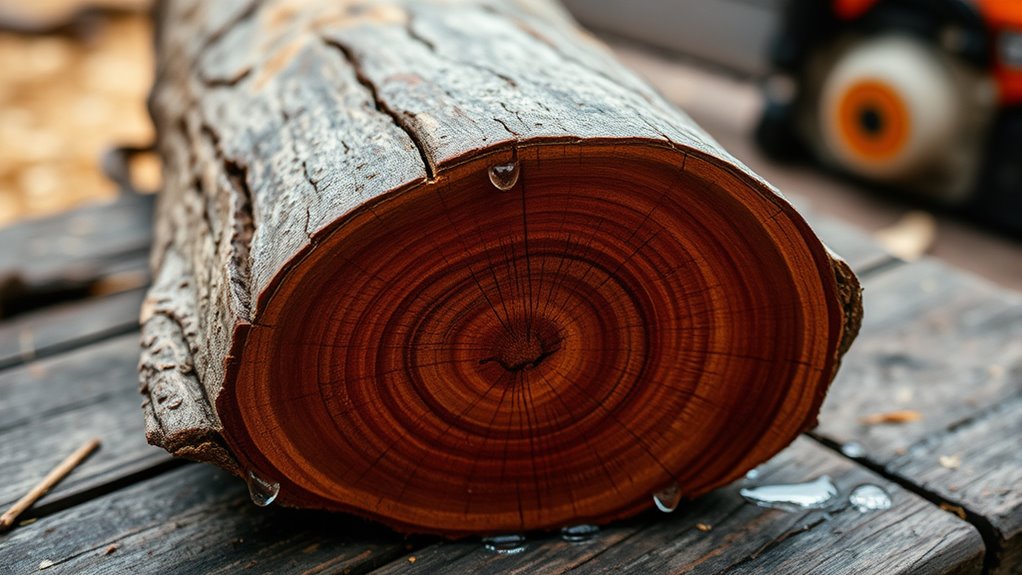
When firewood contains too much moisture, it becomes substantially harder to split and burn effectively. A moisture imbalance causes wood to be dense and resistant, leading to increased effort during splitting. Additionally, excess moisture results in inefficient combustion, producing more smoke and creosote buildup. You’ll also notice wood cracking unevenly as it dries unevenly, further complicating the process. Properly managing resources and tools like moisture meters can help ensure optimal moisture levels. Using modern tools and technological advancements can improve the accuracy of moisture measurement, making it easier to achieve the ideal levels. Implementing proper storage techniques can prevent excess moisture absorption and maintain quality. Regularly checking wood moisture content with reliable devices can help prevent issues caused by improper moisture levels. Ignoring proper moisture levels compromises both safety and performance, emphasizing the importance of controlling moisture content for ideal splitting and burning.
Tips for Storing and Seasoning Firewood for Optimal Moisture Balance
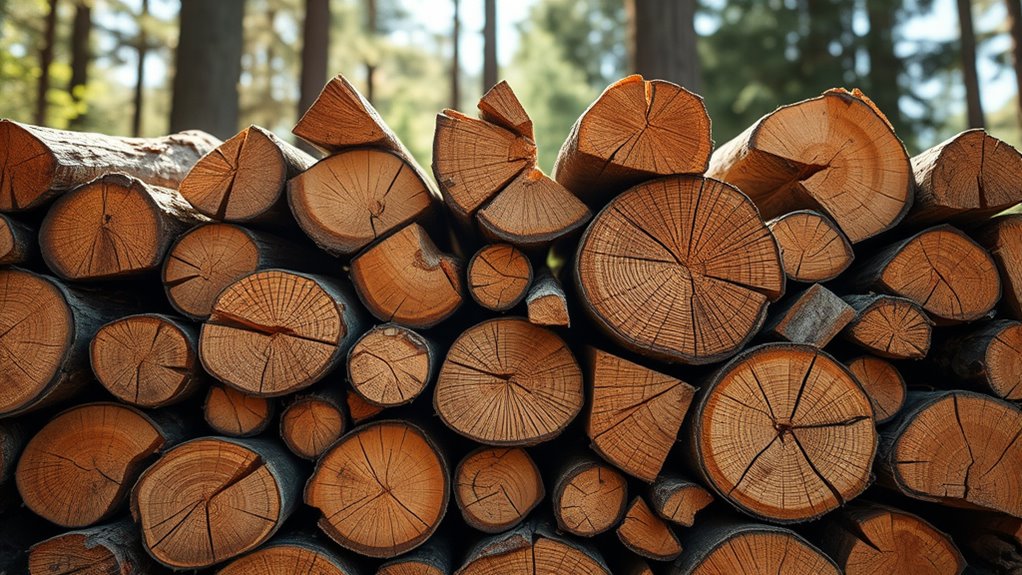
Proper storage and seasoning are essential to guarantee your firewood reaches the ideal moisture level for efficient burning. To achieve this, use effective seasoning techniques such as stacking logs in a single row with good airflow and covering the top to protect from rain while allowing sides to breathe. Choose proper storage solutions like a well-ventilated shed or open-air rack, keeping logs off the ground to prevent moisture absorption. Avoid tightly bundling firewood, as poor airflow hampers drying. Regularly check moisture levels with a moisture meter to ensure logs are seasoned correctly, typically around 20%. Proper storage and seasoning not only improve burning efficiency but also reduce creosote buildup and increase the lifespan of your firewood.
Frequently Asked Questions
How Does Wood Species Affect Optimal Moisture Levels for Splitting?
Wood species influence the ideal moisture levels for splitting because of differences in wood density and porosity. Denser woods with lower porosity, like oak, require slightly drier conditions to split easily, while softer, more porous woods like pine stay workable at higher moisture levels. Understanding these differences helps you adjust moisture content, making splitting easier and safer, and ensuring better firewood quality.
Can Climate Influence the Ideal Moisture Content for Firewood?
Have you ever wondered if climate variability and seasonal changes could affect the ideal moisture content for firewood? It’s a compelling thought, because climate influences how wood dries and retains moisture. In wetter seasons or more humid climates, wood may need longer drying times to reach that perfect moisture level. So, yes, climate definitely plays a role, making it essential to adjust your firewood preparation based on seasonal and environmental shifts.
Is There a Difference in Moisture Needs for Indoor Versus Outdoor Burning?
You should consider that indoor burning typically requires lower moisture content for better fireplace efficiency, usually around 20%, to guarantee complete combustion. Outdoor drying often results in slightly higher moisture levels, which can still be safe for burning if the wood is seasoned properly. Using well-dried wood improves fireplace efficiency and reduces smoke. Always check moisture levels before burning, especially for outdoor drying, to keep your fire safe and efficient.
How Often Should Moisture Levels Be Rechecked During Seasoning?
Think of seasoning like aging fine wine—you need to check regularly. You should recheck moisture levels every few weeks to verify moisture stability. This helps you determine if your logs are seasoned properly or need more time. Regular checks during the seasoning duration prevent surprises, ensuring your firewood is dry enough for efficient burning. Staying attentive guarantees your wood reaches the ideal moisture content, maximizing heat and minimizing smoke.
Are There Eco-Friendly Methods to Reduce Moisture Content Naturally?
You want eco-friendly ways to lower moisture content naturally. Try natural drying methods like spreading the wood in a sunny, well-ventilated area, which speeds up moisture loss without chemicals. Additionally, composting methods can help, as placing wood in compost piles can accelerate drying through natural heat. These techniques are sustainable, cost-effective, and reduce environmental impact while effectively reducing moisture content in your logs.
Conclusion
If you think drying firewood is just about waiting, think again. The ideal moisture content isn’t a myth—studies show it’s key to easier splitting and better burning. By measuring accurately and storing properly, you can access the secret to efficient firewood. Don’t leave it to chance; mastering moisture levels means you’ll enjoy hotter, cleaner fires every time. It’s a simple step that transforms your wood into pure firewood perfection.





